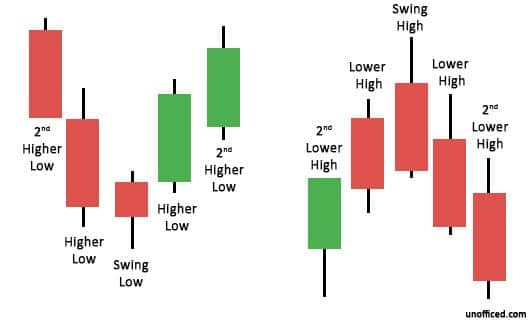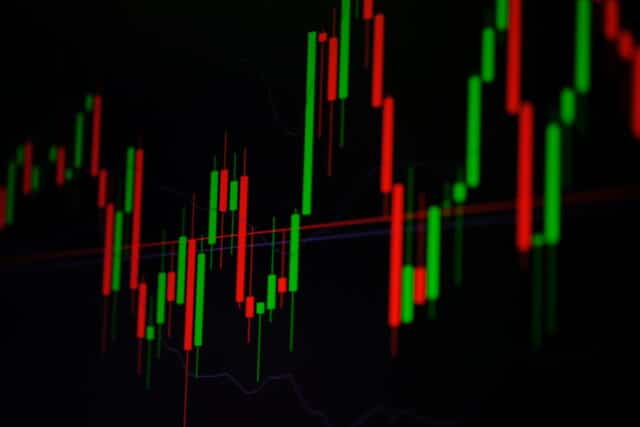Swing trading is a popular type of trading that is less overwhelming for newbies, as it entails a less hectic trading technique while still allowing traders to profit from market movements. Swing trading indicators are used to display support and resistance levels when the trend shifts. It’s not guaranteed to use them as guidelines, and you must broaden your possibilities. Even the most experienced swing trader depends on various indicators to generate the most remarkable outcomes.
Introduction
Swing trading is an approach through which FX investors profit by trading in tandem with the prevalent trend. One can earn by trading in line with an asset’s price swings, which generally last a few days or weeks. It allows profit-taking over a shorter timescale than traditional investment by focusing on the instances when the momentum changes direction. Swing traders, like day traders, seek to take advantage of both rallies and downtrends for profit.

When the price makes a low that is promptly followed by two higher lows, this is known as a swing low(see the image above). A swing high, on the other hand, occurs when the price makes a high, followed by two lower highs.
Aptest indicators for swing trade
The use of mathematical computations to determine various characteristics of price behavior based on previous data is the basis of a swing trading indicator. It may be used to examine the market position on a daily chart or any other chart used.
Types
Momentum – these are used to determine how strong a trend is and whether a reversal is imminent. They can also identify whether a stock is overbought or oversold.
Trend – these show you which way the market is moving and whether or not we can detect a trend. They are often used to moderate price volatility and emphasize the fundamental trend.
Volume – This is a key metric that reveals how many traders are buying and selling a certain asset at any one moment. An example is the volume indicator.
Stochastic indicator
This is a type of momentum indicator that works in the same way as the RSI. It compares a market’s closing price to the range of its prices over a specified time period. The stochastic oscillator is shown on a chart with a range of zero to 100. A value of more than 80 is considered overbought, while a reading of less than 20 is considered oversold.
The indicator has two lines. One indicates the oscillator’s current value, while the other shows a three-day Moving Average. Strong trends can persist in either region for lengthy periods of time, so an overbought or oversold signal doesn’t always imply a reversal is coming. As a result, many traders keep an eye out for when the two lines of a stochastic oscillator cross, seeing this as a warning that a reversal is approaching.
Ease of movement indicator (EMV)
This is a momentum indicator that shows the relationship between the rate of change in the price of an asset and the volume of that asset. It’s most common on the daily chart and in longer periods.
This indicator is represented on a chart with zero as the starting point. When it increases over zero, it indicates that the market’s price is rising with relative ease, and the higher the EMV rise, the more readily the price will rise. When the EMV falls below zero, it means the market is falling with increasing ease.
The volume indicator
Swing traders need volume because it gives them insight into the strength of a new trend. The underlying premise is simple: a trend with a large volume will outperform one with a low volume. There is a greater basis for price activity when there are more traders buying or selling.
As part of a breakout plan, volume is very useful. Breakouts usually occur after a period of consolidation marked by low volume. The volume then rises as the breakout takes hold.
Moving Average (MA)
MAs are classified as short-, medium-, or long-term depending on the number of periods, such as 50-day or 200-day. There are two types of MA, Simple Moving Averages, which average all of a period’s closing prices, and Exponential Moving Averages, which give greater weight to the price that is closest to the present date.
Used when there is a MA crossover, i.e., a market’s short-term MA crosses a longer-term MA, suggesting a change in momentum. A bull move is indicated when a fast MA crosses a slower MA from below. When a faster MA crosses a slower one from above, the momentum is likely to become bearish.
Relative Strength Index (RSI)
Momentum indicators are popular among swing traders because they reveal possible oscillations within a larger trend. The RSI indicator tells if a market is overbought or oversold, and hence whether a move is imminent. The RSI counts the frequency and magnitude of positive and negative closes in a market over a certain number of periods. It’s illustrated by an oscillator, which is a chart that goes from 0 to 100.
Anything above 70 is considered overbought, which might signal the start of a short trade. Meanwhile, when the RSI falls below 30, it is considered to be in the oversold zone. This is frequently seen as a signal to go long. If a market is in an uptrend, but the RSI rises over 70, the market may be on the verge of becoming a bear market. If its RSI continues low, though, the trend may be poised to continue.
Summary
Swing trading is a strategy that focuses on buying low and selling high. There are three types of indicators used, volume, momentum, and trend. The best indicators to use are Moving Average, Stochastic, Ease of movement, Relative strength index, and volume.




